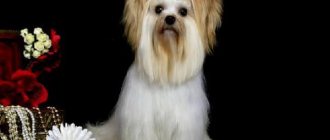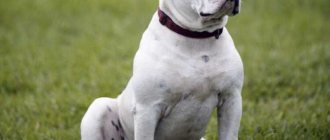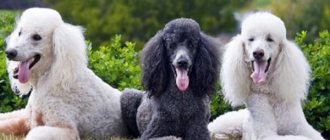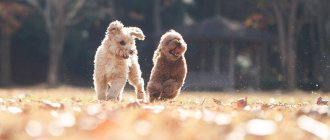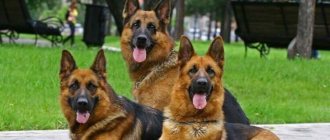The history of the Pomeranian Spitz goes back several centuries. It has long been in demand among lovers of decorative dogs. One of the youngest varieties of the breed is the Japanese Pomeranian. Snow-white pets look like toys; it is impossible to look at them without smiling and admiration. Miniature dogs are not only cute in appearance, but also delight with their perky character, friendliness and temperament. To properly organize maintenance, upbringing and training, you need to know the exterior features of the Japanese orange, its character, habits, rules of care and feeding.
Origin of the breed
The ancestors of the “Japanese” are considered to be the German Spitz or the short Samoyed husky.
The first representatives of the breed were shown at an exhibition in Tokyo in 1921. Breeders devoted the next 10 years to the new breed. To improve it, white dogs of the Spitz family were crossed, which were brought to Japan from all over the world. The final stage was crossing with the American Eskimo Spitz.
In 1948, the Japanese Kennel Club adopted a breed standard. Two years later, elegant fluffies gained popularity. But international recognition came to them only 14 years later.
Description of the breed
Appearance
The Japanese or Dwarf Spitz is a small dog with thick white fur and a pointed, fox-like face.
They have a dense constitution. Despite their small size, these four-legged animals are harmoniously built. Although Japanese Spitz are popularly called dwarf, adult dogs quickly outgrow the “mini” size. The height at the withers reaches 40 centimeters. Weight ranges from 5 to 10 kilograms. Boys are usually larger than girls and have larger facial features and thicker fur.
Head and muzzle
Fox muzzle
The head is proportional to the body. The cranial part widens towards the back of the head, and the rounded forehead protrudes moderately.
The transition from the forehead to the muzzle, which resembles a fox, is noticeably pronounced. It ends with a small coal nose. Thin lips with black edging fit tightly to the jaw. This makes the dog appear to be smiling. Small teeth are located close to each other. The bite is correct, scissor-shaped. The eyes are medium-sized, regular almond-shaped. Due to the very dark color of the iris, the pupil is not visible. Eyelids black. The ears are shaped like triangles, set high with a slight slope.
Frame
Strong build
This elegant dog has a fairly strong build. Due to its proportions, it has the outline of a square.
The height of the body is related to its length as 10:11. The muscular neck goes into a clearly visible withers. The back is straight and short, the loin is wide with a sloping croup. The chest is deep, the ribs are convex, the stomach is tucked. But this is not noticeable because of the fluffy fur. The limbs are smooth and muscular. In the stance, the hind legs are wider apart than the front legs. The dog has strong, fleshy black pads. The claws are also painted black. The tail is covered with long hair and carried over the back. According to the standard, the tail may be slightly lowered towards the hip.
Wool
Thick coat
The coat consists of two layers: a dense, soft undercoat and straight, moderately hard guard hair.
The hair on the face is short. But the neck is covered with a lush collar of long wool.
Color
Sprinkles of a different color in the coat are a serious fault.
The Japanese Spitz has a standard white coat and undercoat color.
Features of character and disposition
This friendly, energetic dog needs constant human contact.
Personality: cheerful.
A representative of the breed will be an ideal family pet, as it is obedient and will withstand the pranks of a small child without causing harm in return. He will make friends with any domestic animal. The “Japanese” will be a brave and attentive watchman. At the same time, the dog does not create unnecessary noise. This is the difference of the breed.
Health
The average life expectancy of a Japanese Spitz is about 10-16 years. Representatives of the breed are distinguished by their longevity. By nature, the Spitz has good health, it has excellent heredity, genetic problems and viral diseases very rarely arise.
It depends on the owner how healthy his dog will be. It is important to monitor the condition of the animal, if you detect signs of illness, do not self-medicate, but immediately seek help from a veterinarian.
Routine vaccinations, preventive examinations at a veterinary clinic, and medications for helminths and skin parasites are also necessary.
The Japanese Spitz has been noted to be predisposed to the following health problems:
- Dislocations – a joint is displaced from its normal position.
- Excessive tearing - This phenomenon occurs due to too small tear ducts or due to stress.
- An allergic reaction often occurs to care products, in particular to shampoo.
- Cataracts are an eye disease that can lead to complete loss of vision.
- Intestinal volvulus - happens due to poor quality food and improper diet.
- Oncological diseases are more often observed in older Spitz dogs.
Breed defects
Drop ears are a breed defect.
Any difference from the standard is considered a breed defect.
For example:
- snack or undershot;
- double curled tail;
- noisy and cowardly dogs.
Vices for disqualification include:
- drooping ears;
- tail that does not lie on the back.
Boys are checked for the presence of two well-developed testes.
How to care, hygiene
Conditions of detention
The dog needs active walks.
Representatives of the breed are not afraid of cold weather, but it is better to keep them at home. This harmonious and elegant dog feels comfortable both in an apartment and in a private house. Being close to a person is vital for these furbabies, but sometimes they can be walked without a leash.
Learn more about American Eskimo Toy Spitz.
Despite their playful disposition, representatives of the breed are quiet at home and do not cause trouble. In addition, they are distinguished by their cleanliness, so even a novice dog breeder can handle the care. The “Japanese” dog can be trained to use a litter box, but this does not cancel out walks twice a day. One walk should be devoted to outdoor games. This provides moderate exercise for the dog.
Training your four-legged companion will not take much time. It is enough for the dog to learn the basic commands.
Shedding and grooming
Brush your dog when shedding.
A thick coat requires simple grooming. Your pet's snow-white hair will cause a little trouble during shedding in spring and autumn.
In addition to a special massage brush, you can use a slicker brush. The coat should be brushed at least twice a week. This will prevent the formation of tangles. Particular care should be taken to comb the fur under the belly and armpits. These cute dogs do not smell like a dog, and their white coat retains its ideal appearance for a long time. Wool is covered with natural impregnation, to which moisture and dirt do not stick. This deprives the owner of the “Japanese” of many troubles.
Bathing
The Japanese don't like to swim.
These cute creatures are not fans of various hygienic activities.
While the Japanese Spitz is still a puppy, it needs to be trained to perform grooming procedures. Wash the dog once a month. Stock up on a special bathing product at the pet store.
Our shampoos and soaps can dry out your dog's sensitive skin or cause allergies.
After bathing, apply a special balm. It will make the fur more shiny and protect it from tangling. Then dry your pet's fur with a towel. Dried hair should be combed with a special comb. Weekly teeth brushing and gum inspection are required.
Eyes and ears
Up to a year, special care is needed.
The eyes of the “Japanese” are particularly sensitive. In puppies under one year of age, they often become watery.
They are washed every day with a cotton pad or napkin moistened with boiled water. If during a walk a speck gets into your pet's eyes, rinse them with a decoction of chamomile. If necessary, your veterinarian will prescribe eye drops. Every week, inspect and clean any excess wax from your four-legged furry's ears with a cotton swab.
Claws and paws
The strength of the claws can be tested on things.
Paws are wiped after returning from the street. The fur between the pads is trimmed as it grows.
The claws of your four-legged companion are trimmed every month. They do this with a claw clipper. If you can't do it yourself, a professional groomer will help you.
Ticks and fleas
Prevention will prevent the appearance of ticks and fleas.
If you neglect to care for the thick fur of your four-legged friend, fleas may appear.
Therefore, prevention needs to be done regularly. Pet stores have plenty of drops, sprays and other products that will help get rid of fleas or are suitable for prevention. As a measure to prevent ticks, you should carefully examine your pet after walking in the forest or tall grass.
Worm prevention
Increased appetite in the “Japanese” is not always a symptom of worms, since dogs are prone to overeating.
You should contact your veterinarian if your pet has problems with digestion or lethargy. To prevent worms, your dog needs to take an anthelmintic every three months. The veterinarian will select the necessary drug.
Diet and feeding regime
Feeding from the table is prohibited.
Proper nutrition is the key to the health and longevity of your four-legged friend. Ready-made super-premium food is suitable for feeding. They are balanced and correspond to the age and health characteristics of the four-legged animal.
If you are going to prepare your own food, use beef or veal as a base. Twice a week you can treat your pet to beef offal or boneless sea fish. Rice and buckwheat are excellent sources of carbohydrates. Fermented milk products are given regularly. You can add vegetables to your diet. You need to give your dog clean drinking water.
Diet plays an important role. The number of feedings depends on the age of the dog and ranges from 5 times a day for a three-month-old puppy to 2 times a day for an adult dog. You should not allow snacks between meals. Due to the gluttony of the “Japanese”, regular overfeeding leads to obesity.
Feeding “from the table” is strictly contraindicated.
Nutrition
In general, the Japanese Spitz is not whimsical, because it was created for the comfort of its owners. But giving bones and very hard elements in food is not recommended, regardless of age. It is better to feed your pet dry food or natural products such as:
- buckwheat;
- rice;
- vegetables;
- beef;
- fish (not raw and thoroughly cleaned of bones).
You should select food according to the size of the dog: miniature.
Premium dry dog food
Rating
Holistic dog food
Rating
Small breed dog food
Rating
Spitz diseases: risks and prevention
“Japanese” are practically not susceptible to genetic diseases, so the breed is considered safe. Representatives of the breed are at risk for the following ailments:
- conjunctivitis (inflammation) of the eyes;
- thyroid diseases;
- epilepsy;
- dysplasia (deviations in the structure) of the hip joint.
A veterinary clinic can conduct a genetic test to determine whether the animal is a carrier of the damaged gene or not. Vaccination is necessary for a puppy to prevent various infectious diseases. Annual vaccinations will improve your pet's health.
Varieties
In fact, modern Shibas appeared by crossing three varieties of breeding dogs selected by specialists. The table describes the characteristics and region of residence of the animals, thanks to which the rare Japanese breed was restored in the post-war period.
Table - Varieties of parent dogs of modern Shiba Inu
| Species name | Region of residence | External features |
| Shinshu-shiba | Nagano | — Red color; - spiny spine; - delicate undercoat |
| Mino-shiba | Gifu | Brick wool color |
| Sanin-shiba | North-west of the country | — Large size; - monochrome coat color |
As for the modern varieties of Shiba Inu, there is only one. Its name is written as “jomon-shiba”. This is a fit, taller dog, the shape of the skull and the structure of the teeth are visually different from the “cheeked” Shiba.
The Jomon Shiba is a breed that is popular among dog breeders and connoisseurs in Japan, but is practically not found outside its homeland.
How to choose the right puppy
Buy puppies from kennels
A photo of a fluffy Japanese Spitz puppy instantly lifts your spirits. To acquire a four-legged friend, you will have to work hard.
Although the breed is not widespread in our country, nurseries have already appeared that breed “Japanese”. If you want to save money and are not afraid of getting a mixed breed or a puppy with genetic abnormalities, you can look for advertisements for sale.
What to pay attention to
You should start by examining your parents. Both must meet the standard not only in appearance, but also in behavior. The adult dog is friendly but wary of strangers and does not bark without good reason. Then we move on to the puppies. The puppy is inquisitive, playful, and constantly on the move. He should have a cool nose, a soft belly, healthy skin and snow-white fur. The nursery must provide you with a pedigree and vaccination passport.
Cost on Avito
If the Japanese Spitz has won your heart, and everything about the breed has already been studied, all that remains is to decide on the purpose of purchase. You need to decide whether the dog will participate in exhibitions or not. The more hopes you place on a future champion, the more expensive he is. The price for one puppy on Avito ranges from 10 to 60 thousand rubles.
Photo review
Take a look at the photos of Shiba Inu puppies and dogs - and you will immediately understand that it was the “Japanese” who gave birth to the famous Internet meme. That very smiley dog that lifts your spirits with just its appearance. The cheeky Shiba Inus give the impression of being eternally happy and cheerful dogs, which is why they became the prototype for creating a witty piece of cultural information.
Owner reviews about the breed
The first owner of a Japanese Spitz in Russia was trainer Nikolai Pavlenko. He described his experience this way:
This was my first Japanese Spitz dog. We have had and still have dozens of dogs... All of them are loved. And Rikki was human. I was in seventh heaven. Nothing but happiness and joy from communication...
Alena Voronetskaya, Spitz breeder (kennel “Sakura Show”):
I didn't have dogs, only ordinary "noble" cats. But, like many, I dreamed of a dog. I really liked Samoyeds, but they are too large for an apartment. I also liked Pomeranian Spitz, but that was also not the case... And one day I saw a Japanese Spitz on the Internet - and the mosaic came together: white, fluffy and Spitz.
Eva Pavlovna:
We gave this cute creature to my sister for her birthday, but after seeing how cheerful, funny and playful this baby is, we decided to get one for ourselves. They have a certain innate aristocracy, they are very smart, clean and don’t shit anywhere (about going to the toilet, they somehow immediately found a common language with him).
If you get a puppy, you need to remember about basic care, in addition to feeding (we feed with good food, which was recommended by the breeder). We clean the eyes daily, check the ears once a week, carry out prevention against worms and fleas (once every 3 months), vaccinations according to age.
The only negative, in my opinion, is the price of a purebred puppy, but believe me, it’s worth it!
TOP nicknames
Most often, Japanese dogs are called by oriental names, which have an interesting semantic translation. When choosing nicknames for a Shiba Inu “boy”, it is worth focusing on his positive qualities and character traits, emphasizing the puppy’s courage, endurance and fortitude. But when choosing nicknames for a Shiba Inu “girl,” it is better to rely on beauty. Let the name turn into a compliment that the owner will repeat dozens of times every day. The table offers two dozen names for males and females of the Japanese breed with their literal translation into Russian.
Table - Nicknames with meaning for Shiba Inu
| For boy" | For girl" | ||
| Nickname | Translation | Nickname | Translation |
| Eisei | Immortal life | Fuwari | Tender |
| Fugue | Elegant | Fubuki | Snowstorm |
| Heishin | Favorite | Tsuta | Wild grapes |
| Heiki | Calm | Yugata | Twilight |
| Yusi | Brave Warrior | Yutori | Space |
| Yasu | Harpoon | Ewan | Lovely |
| Abe | Exceptional Courage | Ame | Rain |
| Tsure | Companion, friend | Engisen | Coin for good luck |
| Yakei | Night Watch | Etsu | Joy |
| Yumei-na | Famous | Fujin | Lady |
Related breeds
The Spitz family is like a colorful kaleidoscope. The size of representatives ranges from dwarf to those whose height at the withers reaches more than 50 centimeters. Spitz breeds include:
- German;
- Pomeranian;
- Finnish;
- American Eskimo;
- Italian Spitz Volpino;
- Eurasian;
- Greenlandic;
- Karelian-Finnish Laika;
- Karelian bear dog or Karelian bear husky.
Spitz varieties
The peculiarity of the Japanese Spitz is that it is suitable for any dog owner. These dogs are able not only to cheer up, but also to bravely protect the owner. A mischievous fluffy dog with a sharp mind will be an ideal family pet or a wonderful companion and understanding interlocutor for a lonely person.
Character
Japanese Spitz are unusually cheerful and friendly dogs that get along well with all family members, especially with children. They are attached to the owner, but at the same time they are delicate and do not show intrusiveness. The main thing for a Spitz is to always remain in a person’s field of vision, otherwise he will be very lonely.
Spitz dogs have one character trait. Getting used to universal adoration and admiration, they gradually occupy a dominant position, cleverly manipulating people in their own interests. To prevent this from happening, the puppy must immediately be explained who is the real owner in the house.
Well, besides this, Spitz are energetic, active, friendly and completely non-conflicting. At the same time, they are laconic and rarely show their voice.
Spitz dogs, like other decorative dogs, do not require special training, but these smart animals are able to learn a few simple commands.

